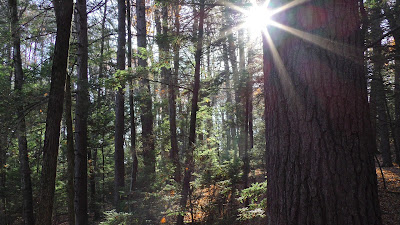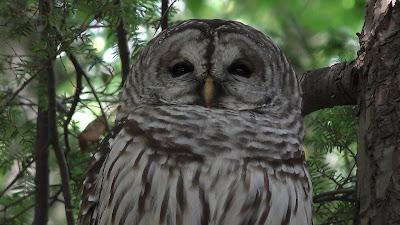The Metacomet Ridge in Massachusetts
Through the heart of the Connecticut River Valley in Western Massachusetts (an area also known as the Pioneer Valley) runs an ancient basalt mountain range known as the Metacomet Ridge. Its history goes back to the time of the split of the North American continent from Africa and Eurasia. The Connecticut River runs through a gap in the chain; on the east side of the river lies Mount Holyoke, and the Seven Sisters peaks of the Holyoke Range. On the west side is the Mount Tom Range.
 |
| Mt Tom Range, from Mt Holyoke |
Both of these mountains are steep, and steeped in history. Each had famous summit houses in the 1800's that were well known far and wide, and were cherished destinations for those seeking exquisite views of the expansive valley. President and Mrs. William McKinley visited the Mt Tom summit house in 1899, accompanied by dapper Secret Service agents.
Both ranges are now state owned, open to the public for passive recreation. Mt Tom State Reservation is almost entirely forested (as is the Mt Holyoke Range), and, together with abutting forest lands, offers many square miles of wildlife habitat of varying types.
 |
| Mt Tom forest |
Wildlife Video of Mt Tom
For the last two years or so, my daily life has revolved around Mt Tom, since I undertook a personal self-challenge to document via video footage as much of the wildlife there as I could. The goal was to present a four-season story of wildlife on the range, one that would hopefully surprise some of my valley neighbors with scenes of critters whose presence they were unaware of, or at least would rarely get to see.
I've been doing this kind of thing on and off for many years, so I knew how to go about it. To candidly capture wildlife on "film", you need to be sitting very quietly and patiently for hours on end, day after day, and in many places all at the same time. Otherwise, it will take decades to get enough lucky opportunities to film a variety of wary creatures.
 |
| One of the Mt Tom clean-up crew |
Of course, I didn't have that much time to wait, and couldn't be but in one place at a time. So, thankfully technology has come a long way since real "film" was the rage. Digital high-definition video camera traps (aka trail cams) are now available, and they can be on the job 24/7, freeing me to spend daylight hours hunkered down with a video camera in a lesser number of productive locations. The camera traps are motion activated, and completely silent in operation; some also use invisible infrared light to illuminate subjects at night, so animals won't be spooked.
These cameras are a godsend. Well-- the right ones are. My first investment in five of them turned out to be months of frustration and disappointment. Oh, they got triggered by moving animals alright. But, rarely was the resultant video clip worth much. Daytime color shots were grossly over-saturated, often badly overexposed, and out of focus; night shots were worse. They would allow identification of what's moving in the area, but didn't produce video I'd want to show anyone. And, those cameras were the "flagship" model of the manufacturer. Yikes.
 |
| Snoozing Barred Owl |
I finally, as they say, bit the bullet and bought five replacement cameras, at four times the cost. That wasn't a particularly easy decision to make, but it was the right one. The new cameras performed much more admirably and reliably (although they really should do even better considering their cost).
At any rate, technology made it possible to accomplish most of my goal in a comparatively short time (ie, compared to sitting in one place at a time over a period of many years).
"Mt Tom Wild" really was a labor of love. Love of the forest and its flora and fauna. One of the most difficult aspects of it all was leaving so much out of the final product. In a project like this, you can accumulate an astounding amount of footage. Much of it of course isn't of value, but you just can't show all of it that is. And you want others to enjoy and appreciate it. But alas, no can do.
There are so many species that I haven't been able to film yet. Plus, there are several rare and/or endangered species on the Mt Tom range that I didn't pursue; they don't need to have me putting more pressure on their existence, nor do they need more exposure to those who would harm or collect them.
So, the hope is that the final 80-minute story is a fair representation of the Mt Tom fauna, and some of its flora. And if it should generate a greater conviction in our collective minds that "special" places like the Mt Tom Range should be protected and preserved forever, well, that would be truly rewarding. But these shouldn't be "special" places, they should be much more common.
You can watch Mt Tom Wild (and other videos) on the New England Forests channel of Youtube, or below. I'd be most interested in your comments. Enjoy!